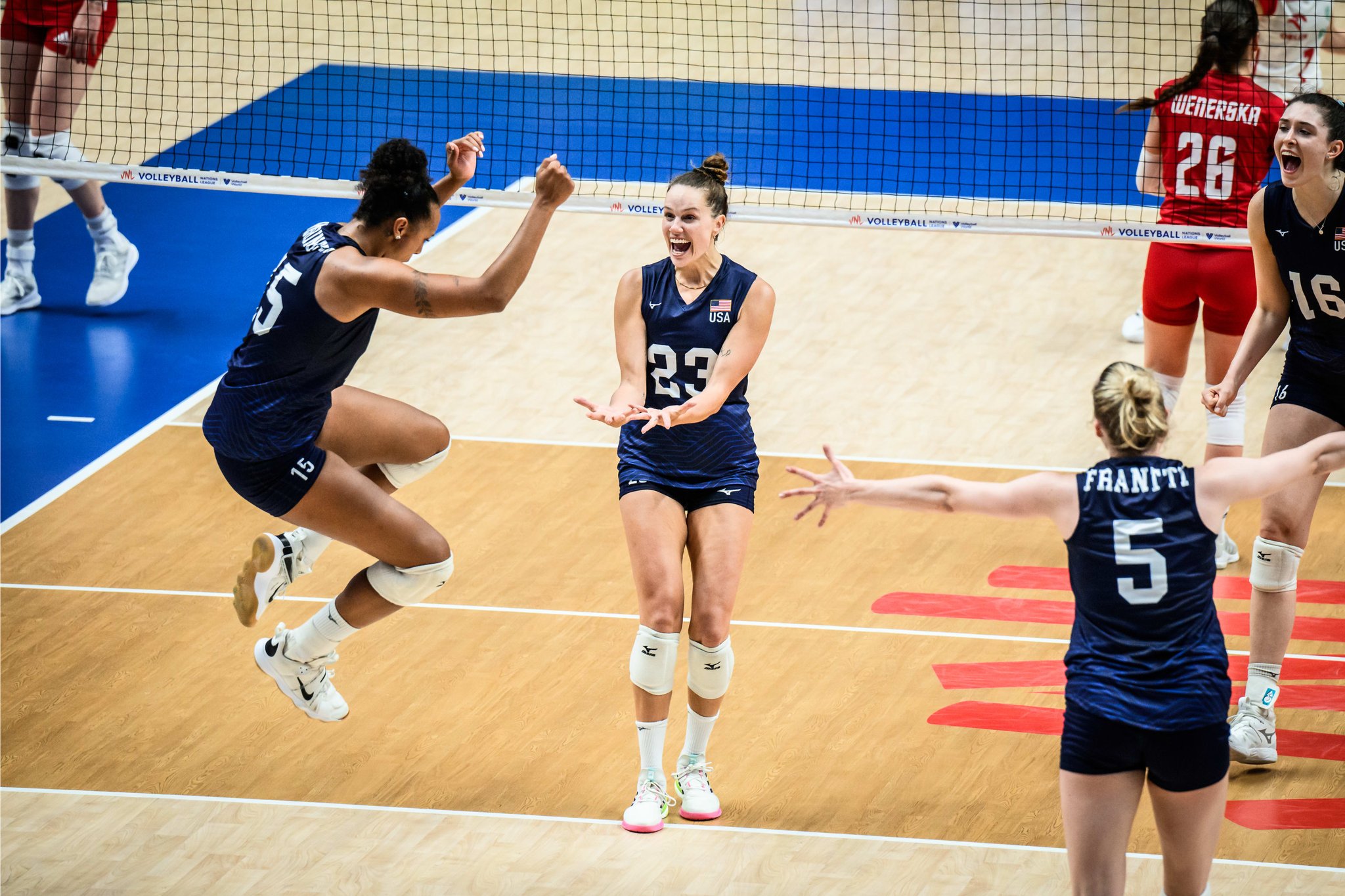How Tall Is USA Volleyball Team: Unveiling The Heights Of The World-Class Players
Volleyball enthusiasts worldwide often wonder about the physical attributes of top-tier teams, including the USA Volleyball Team. Height plays a crucial role in the sport, and understanding the stature of these athletes can provide valuable insights into their dominance on the court. In this comprehensive article, we will delve into the average height of the USA Volleyball Team, exploring player statistics, historical trends, and the importance of height in volleyball.
The USA Volleyball Team is renowned for its exceptional skill, strategy, and physical prowess. As one of the most successful teams in international volleyball, their height is often a topic of discussion. Understanding the height distribution of the team members not only highlights their athletic capabilities but also sheds light on the team's strategic approach to the game.
This article aims to provide detailed insights into the heights of USA volleyball players, supported by data and expert analysis. Whether you're a die-hard fan or a casual observer, this guide will offer a comprehensive understanding of how height contributes to the team's success.
Read also:Austin Uline The Rising Star Redefining The Music Scene
Table of Contents
- Average Height of USA Volleyball Team
- The Importance of Height in Volleyball
- Biography of Key Players
- Height Statistics of USA Volleyball Players
- Historical Trends in Height
- Training and Development for Height Advantage
- Comparison with Other National Teams
- Factors Influencing Height in Volleyball
- Future Trends in Player Height
- Conclusion and Takeaways
Average Height of USA Volleyball Team
The average height of the USA Volleyball Team is a critical factor in their success. According to recent data, the average height of male players is approximately 6 feet 7 inches (200 cm), while female players average around 6 feet 1 inch (185 cm). These figures place the USA team among the tallest in international competitions.
Height provides a significant advantage in volleyball, particularly in blocking and spiking. Taller players can reach higher points on the net, making it more challenging for opponents to score. The USA team leverages this advantage by recruiting players who not only meet height requirements but also possess exceptional skills and agility.
Height Distribution Among Players
The height distribution within the team is diverse, with variations depending on player positions. For instance, middle blockers tend to be the tallest, followed by outside hitters and opposites. Liberos, who specialize in defensive plays, are generally shorter but highly agile.
- Male Middle Blockers: Average height of 6 feet 9 inches
- Female Outside Hitters: Average height of 6 feet 2 inches
- Liberos: Average height of 5 feet 9 inches for women and 6 feet for men
The Importance of Height in Volleyball
Height is a critical factor in volleyball, influencing various aspects of the game. Taller players have a natural advantage in blocking, spiking, and reaching the ball at higher points. This section explores why height matters and how teams utilize it strategically.
Strategic Advantages of Height
Teams with taller players can dominate the net by blocking opponents' attacks effectively. Additionally, height allows for more powerful spikes, increasing the chances of scoring. However, it's important to note that height alone does not guarantee success; skill, teamwork, and strategy are equally important.
Studies show that taller teams tend to perform better in international competitions, as evidenced by the consistent success of teams like the USA, Brazil, and Russia. These teams prioritize recruiting players with optimal height while ensuring they possess the necessary skills to complement their physical attributes.
Read also:Divas Flawless Unveiling The Secrets Of Perfection
Biography of Key Players
Understanding the background of key players provides deeper insights into the team's dynamics. Below is a brief biography of some prominent members of the USA Volleyball Team, along with their height and other vital statistics.
Player Profiles
Men's Team:
| Name | Position | Height | Weight | Birthdate |
|---|---|---|---|---|
| Max Holt | Middle Blocker | 6'9" (206 cm) | 210 lbs (95 kg) | May 18, 1987 |
| Matt Anderson | Outside Hitter | 6'7" (201 cm) | 205 lbs (93 kg) | May 28, 1988 |
Women's Team:
| Name | Position | Height | Weight | Birthdate |
|---|---|---|---|---|
| Kelsey Robinson | Outside Hitter | 6'3" (191 cm) | 170 lbs (77 kg) | August 31, 1990 |
| Rachael Adams | Middle Blocker | 6'3" (191 cm) | 175 lbs (79 kg) | March 3, 1988 |
Height Statistics of USA Volleyball Players
Data analysis reveals interesting trends in the height statistics of USA volleyball players. Over the years, the average height of players has increased, reflecting a global trend in sports. This section provides detailed statistics and insights into player heights across different positions.
Height Trends Across Positions
Position-specific height trends highlight the strategic importance of height in volleyball. Middle blockers, for instance, have consistently been the tallest players, while liberos remain the shortest. This distribution ensures a balanced team structure that maximizes height advantages while maintaining agility and flexibility.
According to a study published in the Journal of Sports Science and Medicine, the average height of volleyball players has increased by 2 inches over the past two decades, emphasizing the growing emphasis on height in player recruitment.
Historical Trends in Height
Historically, the USA Volleyball Team has maintained a competitive edge through its emphasis on recruiting taller players. This section explores the evolution of player heights over the decades and how it has impacted team performance.
Evolution of Height in Volleyball
In the early years of international volleyball, height was not as significant a factor as it is today. However, as the sport evolved, taller players began to dominate, leading to a shift in recruitment strategies. The USA team has consistently adapted to these changes, ensuring they remain competitive on the global stage.
Statistical data from the USA Volleyball Federation shows a steady increase in player heights since the 1980s, aligning with global trends in sports science and athlete development.
Training and Development for Height Advantage
While height is a natural attribute, proper training and development are essential to maximize its benefits. This section discusses the training programs and strategies employed by the USA Volleyball Team to enhance player performance.
Training Programs
The USA team focuses on comprehensive training programs that include strength conditioning, agility drills, and technical skill development. These programs are tailored to individual players, ensuring they can fully utilize their height advantages on the court.
Coaches emphasize the importance of combining height with skill, ensuring players can perform effectively in various game situations. This holistic approach has contributed significantly to the team's success in international competitions.
Comparison with Other National Teams
Comparing the USA Volleyball Team's height statistics with other national teams provides valuable insights into global trends. This section analyzes height data from teams like Brazil, Russia, and China, highlighting similarities and differences.
Global Height Trends
Teams like Brazil and Russia have similar height averages to the USA, reflecting the importance of height in international volleyball. However, each team employs unique strategies to leverage their physical attributes, resulting in distinct playing styles.
Data from the International Volleyball Federation (FIVB) shows that the average height of top-tier teams has increased significantly over the past decade, underscoring the growing emphasis on height in player recruitment.
Factors Influencing Height in Volleyball
Several factors influence player height in volleyball, including genetics, nutrition, and training. This section explores these factors and their impact on player development.
Genetic and Environmental Factors
Genetics play a significant role in determining player height, but environmental factors such as nutrition and training also contribute. Proper nutrition during developmental years ensures optimal growth, while targeted training programs enhance physical capabilities.
Studies indicate that players from countries with well-established sports science programs tend to have taller athletes, highlighting the importance of structured training and development.
Future Trends in Player Height
Looking ahead, the trend of taller volleyball players is expected to continue. This section examines future trends in player height and how teams can adapt to these changes.
Adapting to Future Trends
As sports science advances, teams will increasingly focus on recruiting taller players while ensuring they possess the necessary skills and agility. The USA Volleyball Team is likely to continue its emphasis on height, maintaining its competitive edge in international competitions.
Technological advancements in training and development will also play a crucial role in maximizing player potential, ensuring teams can fully leverage their height advantages.
Conclusion and Takeaways
In conclusion, the height of the USA Volleyball Team plays a significant role in their success on the international stage. Through strategic recruitment, comprehensive training programs, and a focus on player development, the team maintains a competitive edge in the sport.
This article has provided detailed insights into the average height of USA volleyball players, historical trends, and future projections. By understanding the importance of height in volleyball, fans and aspiring players can gain a deeper appreciation for the sport and its evolving dynamics.
We invite you to share your thoughts and insights in the comments section below. Additionally, explore other articles on our site for more in-depth analyses of volleyball and other sports. Together, let's celebrate the incredible achievements of the USA Volleyball Team and the sport's continued evolution.


